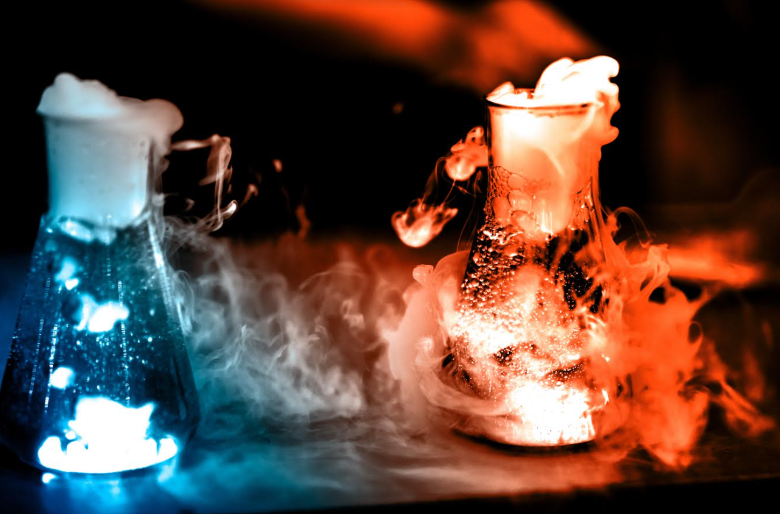 Maths, Physics & Chemistry
Maths, Physics & Chemistry
Same or different? The tale of a tangled molecule
Most great discoveries are a result of happenstance. This is a story about a remarkably complex small molecule that can adopt either of two molecular shapes and how the attempt to synthesize the naturally occurring molecule resulted in the discovery of a unique structural relationship between the seemingly identical molecules.

A seemingly simple question — Are two objects the same or different? — frequently has a complicated answer. For chemists the objects are molecules, and over the years we have refined our ability to make same/different distinctions as we learn more about molecular structures. Molecules are made up of atoms connected to each other, and atoms that seem to be connected in the same way could result in distinct molecules that differ in their three-dimensional shape. Molecules related in this way — same connectivity but different three-dimensional shapes — are called stereoisomers. A common form of stereoisomerism is two molecules related as mirror images. As an example, we can think of our hands, in which fingers and thumb are connected in the same sequence — but they are different in that they cannot be superimposed as we know from trying to wear a left-handed glove on our right hand.
Why does any of this matter? The properties of a molecule are determined by its shape. One stereoisomer can smell like spearmint while its mirror image smells like caraway. However, stereoisomerism goes beyond mirror images of molecules, and we are still learning about the complexities of recognizing and describing these phenomena. Molecular structures can be so complex that they harbor differences that are not apparent to even experienced chemists and cannot be easily described with our canonical set of descriptors.
We have recently discovered a complex small molecule from a symbiotic bacterium of a mushroom and named it tryptorubin A. It is made up of six amino acids (the building blocks of proteins) that are linked in a complex series of cycles joined to each other.
A chemistry lab thousands of kilometers from our lab was fascinated by the compact complexity of this small molecule, and set out to synthesize it. They succeeded in synthesizing what was initially believed to be a synthetic version of the naturally occurring tryptorubin A, but when the two labs compared their versions of tryptorubin A, we realized that they were different. Both labs re- examined their data looking for possible sources of error, and their efforts confirmed that every atom is connected in the same way in both molecules. Eventually, we realized that we had happened upon two different stereoisomers of a very exceptional sort — so unusual that we did not have a good vocabulary to describe the differences between the two structures. An analogy for it would be a pair of pants that could be the usual way or turned inside out. The details of the pants were identical, but they would not feel the same if worn. However, unlike turning clothes inside-out, the two tryptorubin stereoisomers could not be easily interconverted. Converting one to the other would be physically impossible and involve stretching chemical bonds beyond physical limits so that one ring of tryptorubin A could be pulled through the other to yield the respective other stereoisomer.
The best way to verify this model was synthesizing the natural stereoisomer. With this goal in mind, the synthetic approach was adjusted, and, to the delight of both labs, resulted in a compound identical in all respects to the natural tryptorubin A. Hence, the synthesis established the three-dimensional shape relationship of natural tryptorubin A and its original synthetic stereoisomer.
The discovery of this highly unusual form of stereoisomerism is a remarkable example of serendipity — a discovery resulting from happenstance — as it would have remained unappreciated had the first synthesis not produced the unnatural stereoisomer. In addition, the two possible stereoisomers of tryptorubin A serve as a warning that even small molecules like tryptorubin can have a degree of structural complexity that requires both closer analysis and better descriptors for their full structural characterization.
The form of stereoisomerism described in this study is likely not restricted to tryptorubin-like peptides, but has simply been overlooked so far. Answering a version of the question posed at the beginning of this article — What is the difference between the initially synthesized and natural tryptorubin A? — was a reminder that we still have much to learn about the structures of molecules and, perhaps more importantly, that collaborations between labs with different perspectives and skills move science forward.
Original Article:
Reisberg, S. H. et al. Total synthesis reveals atypical atropisomerism in a small-molecule natural product, tryptorubin A. Science (80-. ). 367, 458-463 (2020).
Next read: The plant with the spider-like poison – Australia’s giant stinging tree by Ralph Bulanadi
Edited by:
Dr. Ayala Sela , Associate Editor
We thought you might like
Natural products might just be our best weapon against antibiotic resistance
Apr 3, 2024 in Maths, Physics & Chemistry | 3.5 min read by Olivier Kirchhoffer , Jahn Nitschke , Jean-Luc WolfenderMore from Maths, Physics & Chemistry
Testing gravity through the distortion of time
Sep 20, 2024 in Maths, Physics & Chemistry | 3 min read by Sveva CastelloStacking molecular chips in multiple dimensions
Aug 30, 2024 in Maths, Physics & Chemistry | 3 min read by Lucía Gallego , Romain Jamagne , Michel RickhausReversible Anticoagulants: Inspired by Nature, Designed for Safety
Jun 12, 2024 in Maths, Physics & Chemistry | 4 min read by Millicent Dockerill , Nicolas WinssingerDistance-preserving moves always keep a point fixed
May 18, 2024 in Maths, Physics & Chemistry | 4 min read by Shaula FiorelliA resonance triggers chemical reactions between the coldest molecules
Apr 5, 2024 in Maths, Physics & Chemistry | 3 min read by Juliana Park , Wonyl ChoiEditor's picks
Trending now
Popular topics


